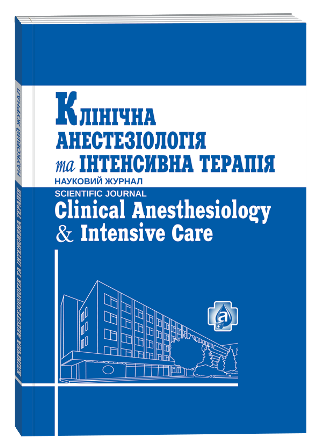POTENTIAL “EFFICIENT” COVARIATES FOR TREATMENT RESULTS PREDICTION IN SEVERE TRAUMA POPULATION
DOI:
https://doi.org/10.31379/2411.2616.17.1.2Keywords:
trauma, survival predictive modelAbstract
Introduction: Despite main well-known epidemiological problem in the last period, injuries are among leading causes of death in all countries of the WHO European Region, regardless of economic status. As we all can understand, the fatal injuries are only a small part of all traumas that are mainly consisted by nonlethal, but sometimes extremely severe injuries. There are some risk and protective determinants of the trauma that make predictable and preventable many injury aspects. Starting from this point, were developed several predictive scores, but they are not universal ones, because of polymorphic aspects of different patients treated within different medical systems. This is the reason why existing scores should be continuously reevaluated and adjusted. In this article, biochemistry data, ionogram and hemoleukogram data, sex, age and comorbidities were considered as predictors and analyzed without anatomical trauma component, which demonstrated the ability to predict in previous studies. These variables were not randomly selected. First, these indicators reflect the state of different organ systems. Second, being “routine” parameters, this information is available for each severe trauma patient admitted to the ICU. Based on the obtained results, potential predictive models adjusted to biological gender and age will be proposed. Purpose and task: To test the routine clinical/paraclinical parameters as severe trauma survival predictors in order to mark potentially “efficient” variables for common trauma scores completion. Methods: An analytical cohort clinical study (retro prospective) was designed to analyze the data of 2651 severe trauma patients consecutively admitted to a trauma center from Republic of Moldova in period between January 2013 – November 2018. The information was extracted from the trauma center electronic database with no personal information. Special inclusion and exclusion criteria were considered. Effective variables / biomarkers / risk factors were identified and studied using statistical data processing in order to develop alternative predictive models of treatment outcomes (survival / death). Results: Almost all parameters included in the study has shown predictive abilities in univariate analysis. Using clinical-paraclinical data including comorbidities, Multivariate predictive model for severe trauma was developed. Conclusion: The biochemical parameters, ionogram and hemoleucogram indicators, reflecting the host response in traumatic injury, represent a potential source for treatment result prediction covariates in severe trauma scores. Moreover, together with comorbidities in multivariate analysis these routine parameters have showed predictive potential.
References
Injuries and violence: the facts. The magnitude and causes of injuries [online]. World Health Organisation, 2020. [02.12.2020] https://www.who.int/violence_injury_prevention/key_facts/VIP_key_facts.pdf?ua=1
Leading Causes of Death and Injury [online]. Centers for Disease, Control and Prevention 2019. [02.12.2020] https://www.cdc.gov/injury/wisqars/LeadingCauses.html
Arnaut, O. Croitoru, D., Grabovschi, I., Sandru, S. Trauma scoring systems. Moldovan Medical Journal. – 2020. – vol. 63, nr.1. – Р. 64-74. ISSN 2537-6381.
Arnaut, O., Baltaga, R., Rojnoveanu, G., Shandru, S. Is a2-macroglobulin a new biomarker for ARDS occurrence in polytrauma patients? Abstracts for the 19th European Congress of Trauma and Emergency Surgery. – 2018. – Р. 321. https://doi.org/10.1007/s00068-018-0934-7.
The Cathepsin D as a Potential Biomarker for Survival Rate in Polytrauma. Pilot Research. / O. Arnaut [et al.] // 4th International Conference on Nanotechnologies and Biomedical Engineering. IFMBE Proceedings. – 2019. – Vol 77. – P.213. https://doi.org/10.1007/978-3-030-31866-6_124. ISBN 978-3-030-31865-9.
Combining the new injury severity score with an anatomical polytrauma injury variable predicts mortality better than the new injury severity score and the injury severity score: a retrospective cohort study. / Ting Hway Wong [et al.] // Scandinavian journal of trauma, resuscitation and emergency medicine. – 2016. – Vol. 24. doi:10.1186/s13049-016-0215-6
Arnaut, O., Rojnoveanu, Gh., Şandru, S. Validarea new injury severity score în traumatismele severe în cadrul sistemului medical autohton. Arta Medica. – 2019. – Vol. 72, nr. 3. ISSN 1810-1852.
Epidemiological comparison between the Navarra Major Trauma Registry and the German Trauma Registry (TR-DGU®). / B. Ali Ali [et al.] // Scandinavian Journal of Trauma, Resuscitation and Emergency Medicine Scand. – 2017. – Vol. 25, nr 1. – P. 1–12. ISSN 1757-7241.
Update of the trauma risk adjustment model of the TraumaRegister DGUTM: The Revised Injury Severity Classification, version II. / R. Lefering [et al.] //Critical Care.- 2014. – Vol. 18, nr. 5. – P. 1–12. ISSN 1364-8535.







